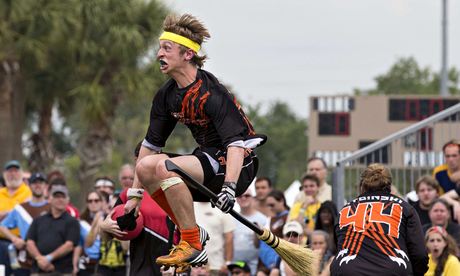
Are there any sports other than quidditch, which I regularly see people playing, that people have been inspired to play by reading about them in a children's book?
Like you I often see a group of people playing quidditch. Of course, as we are unfamiliar with it in reality, it does look pretty strange. It makes me even more in awe of JK Rowling for the power of her imagination that she can persuade grown people to run around outside pretending a twig is a magical broomstick. With no flying – obviously! – I suspect it takes quite a leap of imagination on the part of the participants to make it work.
However, as an observer, the rules of quidditch are really no stranger than the rules of cricket, rugby or even the universally played football, all of which are accepted as entirely credible.
Lewis Carroll's blurs the real rules of croquet in his entirely imaginary version of the game in Alice's Adventure's in Wonderland in which the mallets are live flamingos and the croquet balls are hedgehogs. While few were inspired to adopt his detail, it inspired an interest in the game itself.
Sport has long featured in children's books. In school stories "games" is never a neutral subject. It is as much loathed as loved. In school and outside of school, when loved it has certainly inspired readers to join in. The traditions of this go back a long way.
Playing the game was a very big feature of the nineteenth public schools and the idea that how you play a game is a revealing test of character continues. Taking part in any sport gives children a chance to show courage, tenacity, competitiveness and an understanding of fair play while also creating a tight-knit group of friends – and rivals.
The rules provide a framework for behaviour which exposes individual character quickly. When Tom Brown arrives at Rugby for his first half in Thomas Hughes's classic Tom Brown's Schooldays, almost the first thing he experiences is the football game between School House and the rest of the school for which, mysteriously, the School House team wear white trousers; at the end of the book, a signifier of Tom's success at school is that he is Captain of Cricket. The first of these games, like quidditch, has unfamiliar rules and customs, the second follows a well-published script. Both capture the excitement of taking part in an organised activity while also allowing characters to reveal their deeper characteristics and especially their attitude to individual versus collective success.
Part of the appeal of Enid Blyton's Malory Towers to many readers who have never been to boarding school is the excitement she injects into lacrosse games and the thrill of being part of a team.
In a different but similar context, pony club stories or any other books about the pleasure of riding, have inspired many to yearn to ride although they may never be able to do it. Classic stories about riding such as Enid Bagnold's magnificent National Velvet, the story about a girl fulfilling her dream of riding in the Grand National, as well as current tiles such as Pippa Furnell's Magic Spirit and its many sequels draw of the twin inspirations of love of a pony and the thrill of competitive riding.
Football needs no story to encourage readers to play it but good accounts of it are still inspiring. Scoring that winning goal, making the all-important save, the pleasure of being picked and the pain of being dropped, just being part of the team; all of this and more features in Allan Ahlberg's collection of poems Friendly Matches as well as in countless books for all ages including Tom Palmer's Football Academy and sequels and most recently in his Over the Line, which shows the special place of football in creating a whole regiment during the first world war.

